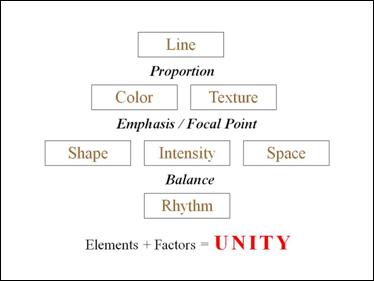
The relationship between art and design is an intimate one, for the same principles govern both a flat stacked float frame and a matted, glazed, framed monoprint. The elements of line, color, texture, shape, intensity, space and rhythm are the building blocks that create both art and frame design. The factors of proportion, balance and emphasis are the mortar that holds the blocks together in an aesthetic way, and when both elements and factors are well used and working together they create a cohesiveness known as unity. Visual design is the organization of materials and forms in such a way as to fulfill a specific and aesthetic purpose. In framing this purpose is to enhance and protect the art.
When it comes to framing, determining a good design from a bad design is actually quite simple. If the framing works well and enhances the art with smooth transitions from outer frame to inner artwork it is potentially a good design. When the layout, mats, colors, and use of rhythm keep the eye moving around the framing and into the art it becomes a successful unified design. If however the viewing is jarred, the eye is caught up in an area of decorative embellishment or color, then perhaps the design needs improvement. The art must remain the visual focus and never be overpowered by the framing. The eye should be allowed to roam around the art and framing viewing all areas of the presentation with ease, yet still be pulled back to the art for the framing to be correctly enhancing and protecting the artwork.

The principles of design are the sum of both the elements and factors, and although all of them might be identified individually, no single element or factor ever works alone. In order for there to be a truly unified design they must all meld into one cohesive well planned and perfectly executed presentation. As an artist uses design elements to produce a masterpiece in pigment or wax, so a framer should produce a masterpiece of framing design.
Elements vs. Factors
The elements are considered the psychological portion of any design, those that an artist, designer, or framer has control over. They are subjective and interpretive and the desire to use them in a particular way comes from within the designer. Even with basic rules framing design is individually subjective and what works for one may never work for another. This is why there are never two competition pieces alike at the PPFA International Finals.
Since the elements of design are the building blocks, the factors are the mortar that holds them together, making them integral to using the elements. Factors are the physical organizers of any design, so even if the perfect colors and textures have been selected to enhance the art, if the balance or proportion of the presentation is off then the design will not hold together having no unity.
This is the first installment in a new series exploring the elements and factors of frame design written for PS Framer.
END
Copyright © 2013 Chris A Paschke
There is a special section in the library for all past issues of Pacific Southwest PPFA Chapter, PS Framer.
For more articles on mounting basics look under the mounting section in Articles by Subject.
Additional information on all types of mounting is found in:
The Mounting and Laminating Handbook, Second Edition, 2002,
The Mounting And Laminating Handbook, Third Edition, 2008 and
Creative Mounting, Wrapping, And Laminating, 2000 will teach you everything you need to know about getting the most from your dry mount equipment and materials as an innovative frame designer.
All books are available from Designs Ink Publishing through this website.
Chris A Paschke, CPF GCF
Designs Ink
Designs Ink Publishing
785 Tucker Road, Suite G-183
Tehachapi, CA 93561
P 661-821-2188
chris@designsinkart.com